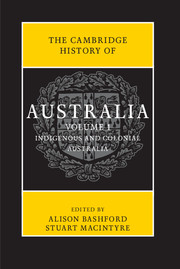Book contents
- Frontmatter
- Contents
- Abbreviations
- List of maps
- List of figures
- List of tables
- Notes on contributors
- Map
- Preface
- Introduction
- PART I
- PART II
- Further reading
- Chronology
- Index
- Frontmatter
- Contents
- Abbreviations
- List of maps
- List of figures
- List of tables
- Notes on contributors
- Map
- Preface
- Introduction
- PART I
- PART II
- Further reading
- Chronology
- Index
Introduction
Published online by Cambridge University Press: 05 November 2013
- Frontmatter
- Contents
- Abbreviations
- List of maps
- List of figures
- List of tables
- Notes on contributors
- Map
- Preface
- Introduction
- PART I
- PART II
- Further reading
- Chronology
- Index
- Frontmatter
- Contents
- Abbreviations
- List of maps
- List of figures
- List of tables
- Notes on contributors
- Map
- Preface
- Introduction
- PART I
- PART II
- Further reading
- Chronology
- Index
Summary
Australia's history has unfolded on vastly different scales, temporal and geographical. It has a human history in ‘deep time’ – an Indigenous history of perhaps 50,000 years – that continues to the present. This temporal expanse confounds both the conventional chronology of human history, measured in far shorter periods, and the geological eras to which deep time normally refers. It is sometimes comprehended by Aboriginal Australians not as a past at all, but as what has become known as the ‘Dreaming’, in which ‘before’ and ‘after’ are indistinct.
Modern Australian history, by contrast, is foreshortened. The colonisation and settlement of the Australian continent by the British took place as part of economic and population growth that marked the eighteenth and nineteenth centuries out from any preceding period in world history. Colonial Australia was a product of the late Enlightenment and of the age of revolutions that hit its stride – for better and for worse – in a century of accelerating agricultural, industrial and demographic change.
Australian history has also unfolded on geographic scales that are both global and local. On one hand, the human past has taken place on a large and geologically old island. In this way, Australian ‘national’ history doubles as the history of one of the planet's continents. The island's location in the southern hemisphere partly explains its foreshortened modern history. From the early seventeenth century Portuguese and Spanish ships accidentally encountered, and sometimes actively explored, the west coast on journeys elsewhere, and the Dutch journeyed along the far south-east coast. In the process Van Diemen's Land was named and, for two centuries, the continent was known by the English as New Holland. At about the same time, fishing and trading expeditions by Southeast Asians began, and gradually turned into seasonal visits, beginning a centuries-long regional connection between communities along and within the Torres Strait and present-day Indonesia.
- Type
- Chapter
- Information
- The Cambridge History of Australia , pp. 1 - 14Publisher: Cambridge University PressPrint publication year: 2013
- 3
- Cited by



